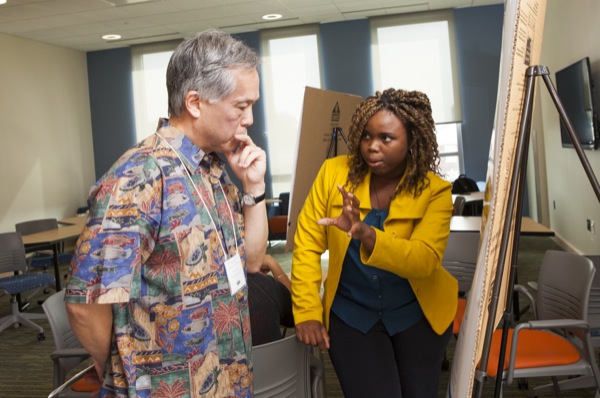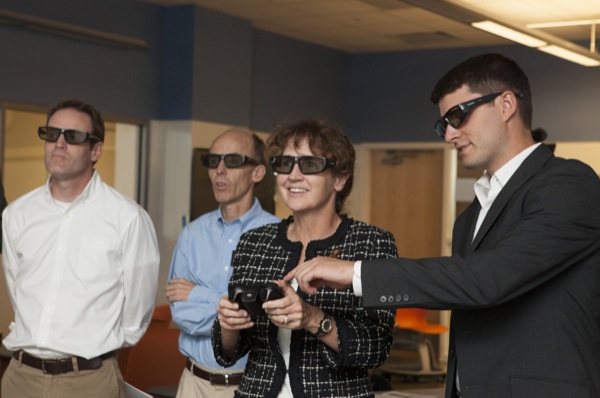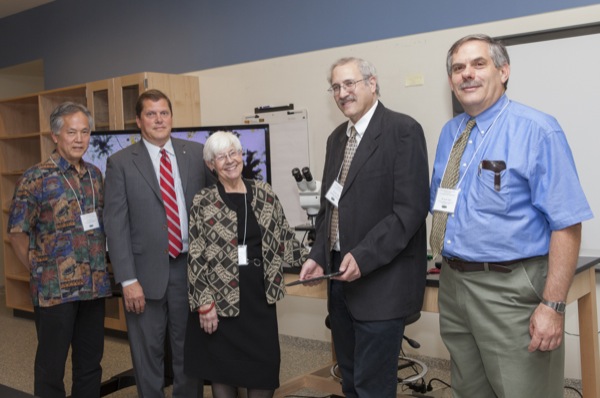


STEM education
Symposium showcases ISE Lab as 'learner-centered environment'
3:46 p.m., Oct. 8, 2013--Of all the students who begin college with an interest in a STEM (science, technology, engineering or math) field, only 40 percent graduate on time and in a STEM discipline. Among minority groups, the loss is even greater; only 20 percent remain in STEM through graduation.
A symposium this month at the University of Delaware brought nationally known speakers, along with faculty members from UD and other institutions, together to discuss this problem and other issues facing STEM education in the 21st century. And the location of the symposium — UD's newest building, the Interdisciplinary Science and Engineering Laboratory (ISE Lab) — was cited as holding part of the answer to attracting and retaining successful STEM students.
Campus Stories
From graduates, faculty
Doctoral hooding
"This building is our investment in how we think students learn best," said George Watson, dean of the College of Arts and Sciences. Calling ISE Lab "a very learner-centered environment," Watson said that the relatively small classrooms and their connected instructional labs mean that "the instructors know all their students and all the students participate in learning."
A physics professor, Watson founded the University's Institute for Transforming Undergraduate Education in 1997 and is a pioneering advocate for problem-based learning. That instructional method, which emphasizes the development of critical thinking skills by having students solve real-world problems, is supported and promoted by ISE Lab's design.
Watson told the symposium audience that the "I" in the building's name could just as easily stand for "integration" or "innovation." ISE Lab, he said, integrates instruction and research, fosters integration among different disciplines, and integrates the real world of scientific discovery into the classroom.
In addition to focusing on new facilities and methods of educating students in STEM fields, universities must also ask, "Who will be learning in buildings like this?" said David Asai, a featured speaker at the symposium. Asai, senior director of undergraduate and graduate science education programs at the Howard Hughes Medical Institute, urged institutions of higher education to think in new ways to retain STEM students, particularly members of underrepresented minority groups.
"Diversity is really good for science," he said, as the increasingly complex problems in research demand more varied perspectives to solve them. The good news is that the U.S. population is becoming more and more diverse, Asai said, but the bad news is that America is failing to take advantage of this talent pool.
African American and Latino students enter college with a rate of interest in STEM disciplines that is similar to the freshman population as a whole. But five years later, some have not yet graduated and some have dropped out of school, but the majority have changed to a non-STEM major, leaving only one in five of those who started out in STEM to graduate in that area.
Universities must do better, Asai said. He encouraged faculty members to take responsibility for keeping their students in STEM by setting high expectations and offering minority students the same opportunities as their peers, as well as listening to their students' views and concerns about diversity.
He also suggested replacing the often-used model of a "pipeline" that takes students directly from high school through college and doctoral studies without interruption. Instead, he used the metaphor of a watershed, in which students come to college to study STEM from a variety of backgrounds — community colleges, the workforce and the military, for example.
Other speakers at the symposium were Jeanne Narum, founding director of Project Kaleidoscope and founding principal of Learning Spaces Collaboratory, which encourage the design and development of an intellectual, physical and organizational infrastructure that supports strong learning in STEM fields; Louis Gross, director of the National Institute for Mathematical and Biological Synthesis, who also was involved in the National Academy of Sciences Bio2010 report, "Transforming Undergraduate Education for Future Research Biologists"; and Jay Labov, senior adviser for education and communications for the National Research Council, who has been the study director for numerous reports on improving teaching in STEM fields.
Those attending the event also had the opportunity to tour the building and visit locations where students, faculty and preceptors demonstrated the kinds of instruction and research happening in ISE Lab.
The building, which opened for classes this semester, will have its formal dedication on Oct. 17.
Article by Ann Manser
Photos by Ambre Alexander










